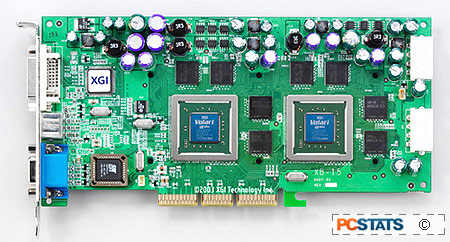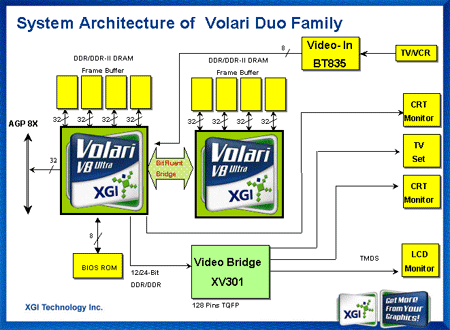 Described by XGI as an "…entry level graphics solution." The
Volari V3
is a Directx 8.1 compatible chip supporting up
to 128mb of DDR. The V3 is a 2-pipeline, 2 texture unit design. The performance
numbers quoted on the website are 300Mhz clock speed, 600MP/s fill rate. The V3
will use a 128-bit DDR memory bus, giving 9.6GB/s of bandwidth at a memory clock
of 300Mhz.
Described by XGI as an "…entry level graphics solution." The
Volari V3
is a Directx 8.1 compatible chip supporting up
to 128mb of DDR. The V3 is a 2-pipeline, 2 texture unit design. The performance
numbers quoted on the website are 300Mhz clock speed, 600MP/s fill rate. The V3
will use a 128-bit DDR memory bus, giving 9.6GB/s of bandwidth at a memory clock
of 300Mhz.
The XP5 series is XGI's
mobile graphics GPU, directly related to the Trident XP5. Composed of a 250Mhz
core with two pixel pipelines, and one vertex and pixel shading unit
respectively, the XP5 will ship in two different versions.
The 64 and 32MB versions will be
the XP5m64 and XP5m32 respectively. The memory is clocked at 250Mhz DDR. XGI
quotes performance numbers of 500 million Pixels/sec peak fill rate, 4 million
texels/sec peak texture rate and 8GB of memory bandwidth.
The
XGI Technology BitFluent Architecture and the Volari Duo V8/V5
Ultra
The BitFluent Architecture is XGI's method of implementing
dual graphics processors on a single video card, the Volari Duo. It
is based on the simple principle of even data flow: One processor is
connected to the AGP 8X bus in the usual manner, while the secondary processor
connects to the first via a data bus with the same maximum
bandwidth as the AGP 8X bus (2.1GB/sec).

With BitFluent Architecture, XGI believe that potential data
bottlenecks inside the card should be minimized.
The
processors will work in parallel, each rendering their own separate frames for
display, with each having access to their own frame buffer and DDR or DDR2
memory. This connection between the two GPUs is called the BitFluent Bridge.

